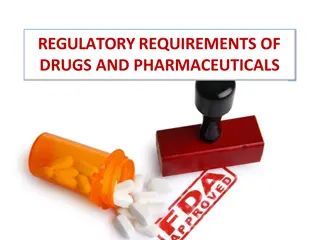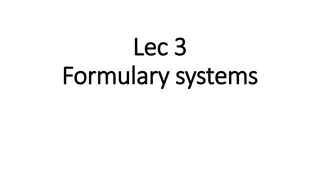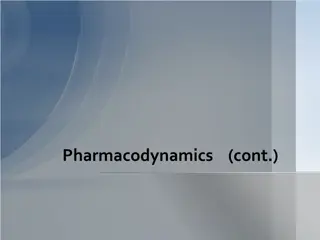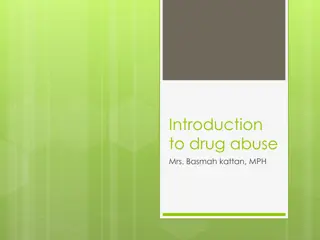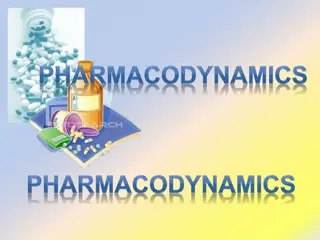Understanding Nasopulmonary Drug Delivery System
Nasopulmonary drug delivery system, utilizing the nasal route for drug administration, offers advantages such as hepatic first-pass metabolism avoidance and rapid drug absorption. This system is beneficial for pharmacologically active compounds with poor stability in gastrointestinal fluids. While it has advantages like good bioavailability for smaller drug molecules and convenience for long-term therapy, there are also disadvantages like potential nasal irritation and limited absorption surface area. Overall, this system provides a reliable alternative for drug delivery that is gaining recognition for its efficacy and convenience.
Download Presentation

Please find below an Image/Link to download the presentation.
The content on the website is provided AS IS for your information and personal use only. It may not be sold, licensed, or shared on other websites without obtaining consent from the author. Download presentation by click this link. If you encounter any issues during the download, it is possible that the publisher has removed the file from their server.
E N D
Presentation Transcript
Nasopulmonary drug delivery system NASO NASOPULMONARY PULMONARYDRUG DELIVARY DELIVARY SYSTEM DRUG SYSTEM Department of Pharmaceutics
NASAL DRUG DELIVERY NASAL DRUG DELIVERY SYSTEM SYSTEM Department of Pharmaceutics
Nasopulmonary drug delivery system In ancient times the Indian Ayurvedic system of medicines used nasal route for administration of drug and the process is called as Nasya Intranasal drug delivery is now recognized to be a useful and reliable alternative to oral and parenteral routes. Undoubtedly, the intranasal administration of medicines for the symptomatic relief and prevention or treatment of topical nasal conditions has been widely used for a long period of time. However, recently, the nasal mucosa has seriously emerged as a therapeutically viable route for the systemic drug delivery. In general, among the primary targets for intranasal administration are pharmacologically active compounds with poor stability in gastrointestinal fluids, poor intestinal absorption and/or extensive hepatic first-pass elimination, such as peptides, proteins and polar drugs. Advantages: Hepatic first pass metabolism avoided. Rapid drug absorption and quick onset of action. Bioavailability of larger drug molecules can be improved by means of absorption enhancer. Department of Pharmaceutics
Nasopulmonary drug delivery system Bioavailability for smaller drug molecules is good. Convenient for long term therapy, compared to parenteral medication. Drugs possessing poor stability in G.I.T fluids can be given by nasal route. Easy and convenient. Easily administered to unconscious patients. Disadvantages: Pathologic conditions such as cold or allergies may alter significantly the nasal bioavailability. The histological toxicity of absorption enhancers used in nasal drug delivery system is not yet clearly established. Relatively inconvenient to patients when compared to oral delivery systems since there is a possibility of nasal irritation. Nasal cavity provides smaller absorption surface area when compared to GIT. Department of Pharmaceutics
Nasopulmonary drug delivery system Cross-sectionalview a nasalvestibule d middle turbinate e superior turbinate (olfactory mucosa) b palate f nasopharynx c inferiorturbinate Department of Pharmaceutics
Nasopulmonary drug delivery system Site of drug spray & absorption PATHWAYS FOR NASAL ABSORPTION Absorption through the olfactory neurons, transneuronal absorption. Olfactory epithelium is considered as a portal for substances to enterCNS. Absorption through the supporting cells & the surrounding capillary bed. Venous drainage: a rich venous plexus is found under the mucous membrane which is drained by veins accompanying the arteries. Absorption into the cerebrospinal fluid. Department of Pharmaceutics
Nasopulmonary drug delivery system NOSE BRAIN PATHWAY: The olfactory mucosa (smelling area in nose) is in direct contact with the brain and CSF. Medications absorbed across the olfactory mucosa directly enter the brain. This area is termed the nose brain pathway and offers a rapid, direct route for drug delivery to the brain. Olfactory mucosa Brain CSF Highly vascular nasal mucosa Department of Pharmaceutics
Nasopulmonary drug delivery system Nasal pH Nasal secretion of adult : 5.5-6.5 Infants and children: 5-6.7 It becomes alkaline in conditions such as acute rhinitis, acute sinusitis. Lysozyme in the nasal secretion helps as antibacterial and its activity is diminished in alkaline pH. MECHANISM OF DRUG ABSORPTION: The first step in the absorption of drug from the nasal cavity is passage through the mucus . Small, unchanged particles easily pass through this layer. However, large or charged particles may find it more difficult to cross. Mucin, the principle protein in the mucus, has the potential to bind to solutes, hindering diffusion. Structural changes in the mucus layer are possible as a result of environmental changes (i.e. pH, temp rature, etc.)subsequent to a drug s passage through the mucus. Department of Pharmaceutics
Nasopulmonary drug delivery system There are several mechanisms for absorption through the mucosa. These include transcellular or simple diffusion across the membrane, paracellular transport via movement between cell and transcytosis by vesicle carriers. Drug absorption are potential metabolism before reaching the systemic circulation and limited residence time in the cavity. Following mechanisms have been proposed : 1) The first mechanism involves an aqueous route of transport which is also known as the paracellular route. This route is slow and passive. There is an inverse log-log correlation between intranasal absorption and the molecular weight of water-soluble compounds. Poor bioavailability was observed for drugs with a molecular weight greater than 1000 Daltons. The second mechanism involves transport through a lipoidal route that is also known as the transcellular process and is responsible for the transport of lipophilic drugs that show a rate dependency on their lipophilicity. Drugs also cross cell membranes by an active transport route via carrier-mediated means or transport through the opening of tight junctions. 2) Department of Pharmaceutics
Nasopulmonary drug delivery system FACTORS INFLUENCING NASAL DRUG ABSORPTION Factors Related to Drug a) Lipophilicity: On increasing lipophilicity, the permeation of the compound normally increases through nasal mucosa because of high lipophilicity though it has some hydrophilic character for some drugs.eg: alprenolol and propranolol. b) Chemical Form: Conversion of the drug into a salt or ester form can alter its absorption. eg: In-situ nasal absorption of carboxylic acid esters of L-Tyrosine was significantly greater than that of L-Tyrosine. c) Polymorphism: Polymorphism is known to affect the dissolution rate and solubility of drugs and as well as their absorption through biological membranes. It is therefore advisable to study the polymorphic stability and purity of drugs for nasal powders or suspensions. d) Molecular Weight: The permeation of drugs less than 300Da is not significantly influenced by the physicochemical properties of the drug, which will mostly permeate through aqueous channels of the membrane. By contrast, the rate of permeation is highly sensitive to molecular size for compounds with MW = >300 Da. Department of Pharmaceutics
Nasopulmonary drug delivery system e) Partition Coefficient and pKa: As per the pH partition theory, unionized species are absorbed better compared with ionized species and the same holds true in the case of nasal absorption. The nasal absorption of weak electrolytes such as salicylic acid and amino-pyrine was found to be highly dependent on their degree of ionization. Although for amino-pyrine, the absorption rate increased with the increase in pH. f) Solubility & Dissolution Rate: Drug solubility and dissolution rates are important factors in determining nasal absorption from powders and suspensions. The particles deposited in the nasal cavity need to be dissolved prior to absorption. If a drug remains as particles, no absorption takes place. Factors Related to Formulation a) pH and Mucosal Irritancy: The pH of the formulation, as well as that of nasal surface, can affect a drug s permeation. To avoid nasal irritation, the pH of the nasal formulation should be adjusted to 4.5 6.5 . Department of Pharmaceutics
Nasopulmonary drug delivery system b) Osmolality: Because of the effect of osmolality on the absorption, isotonic solutions are usually preferred for administration for shrinkage of the nasal epithelial mucosa. c) Viscosity: A higher viscosity of the formulation increases contact time between the drug and the nasal mucosa there by increasing the time for permeation. At the same time, highly viscous formulations interfere with the normal functions like ciliary beating or mucociliary clearance and thus alter the permeability of drugs. Department of Pharmaceutics
Nasopulmonary drug delivery system PULMONARY DRUG DELIVERY PULMONARY DRUG DELIVERY SYSTEM SYSTEM Department of Pharmaceutics
Nasopulmonary drug delivery system The respiratory tract is one of the oldest routes used for the administration of drugs. Over the past decades inhalation therapy has established itself as a valuable tool in the local therapy of pulmonary diseases such as asthma or COPD (Chronic Obstructive Pulmonary Disease). The drug used for asthma and COPD e.g..- 2-agonists such as salbutamol (albuterol), corticosteroids such as budesonide, beclomethasone and mast-cell stabilizers such as sodium cromoglycate. The latest and probably one of the most promising applications of pulmonary drug administration is Its use to achieve systemic absorption of the administered drug substances. Particularly for those drug substances that exhibit a poor bioavailability when administered by the oral route, as for example peptides or proteins, the respiratory tract might be a convenient port of entry. Department of Pharmaceutics
Nasopulmonary drug delivery system Advantages: The dose needed to produce a pharmacological effect can be reduced. Low concentrations in the systemic circulation are associated with reduced systemic side-effects. Rapid onset of action. Avoidance of gastrointestinal upset. Avoidance of intestinal and hepatic first-pass metabolism. Disadvantages: Complex delivery devices are required to target drugs to the airways. Aerosol devices can be difficult to use. Various factors affect the reproducibility of drug delivery to the lungs, including physiological (respiratory maneuver) and pharmaceutical (device, formulation) variables. Drug absorption may be limited by the physical barrier of the mucus layer and the interactions of drugs with mucus. Mucociliary clearance reduces the retention time of drugs within the lungs. Efficient drug delivery of slowly absorbed drugs must overcome the ability of the lung to remove drug particles by mucociliary transport. Department of Pharmaceutics
Nasopulmonary drug delivery system Mechanism of drug absorption: Drug diffusion through alveoli. Absorption by carrier mediated transport. Phagocytosis of insoluble particles allow absorption of compounds with low lipophilicity &/or high molecular weight. The human respiratory system is a complicated organ system of very close structure function relationships. The system consisted of two regions: The conducting airway: The conducting airway is further divided into many folds: nasal cavity and the associated sinuses, and the nasopharynx, oropharynx, larynx, trachea, bronchi, and bronchioles. The respiratory region: The respiratory region consists of respiratory bronchioles, alveolar ducts, and alveolar sacs. The human respiratory tract is a branching system of air channels with approximately 23 bifurcations from the mouth to the alveoli. The major task of the lungs is gas exchange, by adding oxygen to, and removing carbon dioxide from the blood passing the pulmonary capillary bed. Department of Pharmaceutics
Nasopulmonary drug delivery system Anatomy and physiology of lungs Lung region 1. Nasopharynx region (NP) 2. Tracheobronchial region: (TB) 3. Alveolar region: (AV) Department of Pharmaceutics
Nasopulmonary drug delivery system MECHANISMS OF PARTICLE DEPOSITION IN THE AIRWAYS 1) Inertial impaction: This is the main deposition mechanism for particles >1 m in the upper tracheo-bronchial regions. A particle having a large momentum may not able to follow the altering direction of the inspired air as it transferred the bifurcations and it will show result to collide with the airway walls as it continues on its original course. 2) Sedimentation:- By the settling under gravity the particles may deposited. It becomes highly important for particles that reach airways where the airstream velocity is relatively low, e.g. the bronchioles and alveolar region. 3) Brownian diffusion:- This is of minor significance for particles >1 m. Particles smaller than this size are displaced by a sequentially bombardment of gas molecules, which may results in particle collision with the airway walls. The chances of particle deposition by diffusion increases with the particle size decreases. Brownian diffusion is also more common in regions where airflow is very low or absent, e.g. in the alveoli Department of Pharmaceutics
Nasopulmonary drug delivery system NASAL SPRAY Department of Pharmaceutics
Nasopulmonary drug delivery system Now a day s multiple types of formulation are used to administer drug by nasal rout, which includes nasal spray, nasal drop, nasal powder, nasal gels & nasal insert etc. Administration of drugs through the nose in the spray dosage form is a non-invasive method that gives rapid onset of drug action. Because the nasals spray dosage form is cost-effective, easy to use/carry and self-administrable, it has high patient compliance. Both solution and suspension formulations can be formulated into nasal sprays. Due to the availability of metered dose pumps and actuators, a nasal spray can deliver an exact dose. The particles size and morphology (for suspensions)of the drug and viscosity of the formulation determine the choice of pump and actuator assembly. Dymista Nasal Spray: Department of Pharmaceutics
Nasopulmonary drug delivery system Instruction before use Department of Pharmaceutics
Nasopulmonary drug delivery system Department of Pharmaceutics
Nasopulmonary drug delivery system FORMULATION OF NASAL SPRAY: Nasal spray drug products contain therapeutically active ingredients (drug substances) dissolved or suspended in solutions or mixtures of excipients (e.g., preservatives, viscosity modifiers, emulsifiers, buffering agents) in nonpressurized dispensers that deliver a spray containing a metered dose of the active ingredient. The dose can be metered by the spray pump. Nasal sprays are applied to the nasal cavity for local and/or systemic effects. Although similar in many features to other drug products, some aspects of nasal sprays may be unique (e.g., formulation, container closure system, manufacturing, stability, and drug product). Energy is required for dispersion of the formulation as a spray. This is typically accomplished by forcing the formulation through the nasal actuator and its orifice. The formulation and the container closure system collectively constitute the drug product. Department of Pharmaceutics
Nasopulmonary drug delivery system 1) Active Pharmaceutical Ingredient: An ideal nasal drug candidate should possess the following attributes: Appropriate aqueous solubility to provide the desired dose in a 25 150 ml volume of formulation. Appropriate nasal absorption properties. No nasal irritation from the drug. Rapid onset of action. Low dose. Generally, below 25 mg per dose. No toxic nasal metabolites. No offensive odors/aroma associated with the drug. Suitable stability characteristics. 2) Excipients used in nasal spray formulations: There are various types of excipients used in nasal formulations. Commonly used and frequently added excipients are as follows: a) Buffers: Nasal secretions may alter the pH of the administrated dose which can affect the concentration of un-ionized drug available for absorption. Therefore, an adequate formulation buffer capacity may be required to maintain the pH in-situ. Examples of buffer used in nasal spray sodium phosphate, Sodium citrate, citric acid. Department of Pharmaceutics
Nasopulmonary drug delivery system b) Solubilizers: Aqueous solubility of drug is always a limitation for nasal drug delivery in solution. Conventional solvents or co-solvents such as glycols, small quantities of alcohol, medium chain glycerides and Labrasol (saturated polyglycolyzed C8- C10 glyceride) can be used to enhance the solubility of drugs. Other compounds can be used like, the use of surfactants or cyclodextrins that serve as a biocompatible solubilizer and stabilizer in combination with lipophilic absorption enhancers. c) Preservatives: Most nasal formulations are aqueous based so needs preservatives to prevent microbial growth. Parabens, phenyl ethyl alcohol, benzalkonium chloride, EDTA and benzoyl alcohol are some of the commonly used preservatives in nasal formulations. d) Antioxidants: A small quantity of antioxidants may be required to prevent drug oxidation. Commonly used antioxidants are sodium bisulfite, butylated hydroxytoluene, sodium metabisulfite and tocopherol. Usually, antioxidants do not affect drug absorption or cause nasal irritation. Department of Pharmaceutics
Nasopulmonary drug delivery system e) Humectants: Because of allergic and chronic diseases there can be crusts and drying of mucous membrane, certain preservatives/ antioxidants are also likely to cause nasal irritation especially when used in higher quantities. Adequate intranasal moisture is essential for preventing dehydration. Therefore, humectants can be added especially in gel-based nasal products. Humectants avoid nasal irritation and do not affect drug absorption. Common examples include glycerin, sorbitol and mannitol. f) Surfactants: Surfactant incorporation into nasal dosage forms can modify the permeability of nasal membranes, which may facilitate the nasal absorption of drug. It also increases stability of suspension. Common examples include Polysorbate. g) Bioadhesive polymers: They are also called as mucoadhesive if biological material is mucus membrane. The bioadhesive force of a polymer material is dependent on the nature of the polymer, the surrounding medium (pH), swelling and physiological factors (mucin turnover, disease state). They improve the contact time of drug on mucosal surface. Example like chitosan, thiomer. h) Penetration enhancer: Chemical penetration enhancers are widely used in the nasal drug delivery. Example like sulphoxides, azones. Department of Pharmaceutics
Nasopulmonary drug delivery system INHALERS Metered Dose Inhalers(MDI) Dry Powder Inhalers (DPI) Department of Pharmaceutics
Nasopulmonary drug delivery system Metered Dose Inhalers (MDI) Used for treatment of respiratory diseases such as asthma and COPD. They can be given in the form of suspension or solution. Particle size of less than 5 microns. It can be deliver measure amount of medicament accurately. Advantages: It delivers specified amount of dose. Small size and convenience. Usually inexpensive as compare to dry powder inhalers and nebulizers. Quick to use. Multi dose capability more than 100 doses available. Disadvantages: Difficult to deliver high doses. There is no information about the number of doses left in the MDI. Accurate co-ordination between actuation of a dose and inhalation is essential. Department of Pharmaceutics
Nasopulmonary drug delivery system These inhalers consist of a canister, actuator and a spacer. The canister is composed of a metering dose valve with an actuating stem. The formulation (API, liquefied gas propellant and a stabilizer) present in the canister. The drug may be suspended or dissolved in the liquefied gas propellant. Upon actuating, the metering dose valve is opened which releases a single metered dose of medication along with the liquefied gas propellant to spray out of a canister. This process is called Cavitation . The liquefied gas propellant is volatile in nature, which breaks down into liquid droplets and evaporates rapidly & the dried micronized drugs are inhaled to the lung. Department of Pharmaceutics
Nasopulmonary drug delivery system Formulation 1. Active Pharmaceutical Ingredient: Active pharmaceutical ingredient first checked for preformulation studies and particle size should be below 10 m in case of suspension formulation. 2. Propellant: The propellant is used to provide the energy to generate a fine aerosol of drug particles and to expel the concentrate from the container and deliver to lung. The liquefied compressed gases are mainly used because discharge of aerosol undergoes evaporation of propellant to give aerosol of very small particles. A compressed liquefied gas gives consistent pressure throughout the use of content. The traditional pMDI propellant has been chlorofluorocarbon (CFC). However, nowadays CFC has been replaced by hydrofluoroalkane (HFA) due to concern about the environmental effects of CFCs on the ozone layer which filters ultraviolet (UV) radiation posing an increased risk of skin disease and global warming. HFAs do not contain chlorine and thus have no ozone-depleting potential. Department of Pharmaceutics
Nasopulmonary drug delivery system Ideal Properties of Propellant: Boiling point should be between -100 C to 30 C. Density should be in between 1.2 to 1.5 g/cm2. Vapour pressure 40 to 80 psig. Non-flammable, nontoxic, inert and not reactive in formulation. It should have acceptable taste, odor and also should be low cost. It should be compatible with primary packaging material. 3. Stabilizing Agent: Surfactants are used to stabilize the suspension formulation. It also helps in solubilising drug and prevents crystal growth during the storage period. It improves valve lubrication. Surfactants such as oleic acid, sorbitan trioleate are highly soluble in CFC but are not soluble in HFAs, therefore co-solvent are used to dissolve these surfactants in the HFA propellants. Department of Pharmaceutics
Nasopulmonary drug delivery system 4. Co-solvent: Surfactants are highly soluble in CFC but are not soluble in HFA, therefore co-solvent is used to dissolve the surfactants in the HFA propellants. Ethanol is one of the most commonly used co-solvents in pMDI formulation. It lowers the vapour pressure of HFA propellants which produce smaller particle and more respirable drug fractions. It can even increase the solubility of certain APIs which lead to an increased problem of crystal growth. Also increase in ethanol causes decrease in volatility and vapour pressure of the formulation inside the container. Department of Pharmaceutics
Nasopulmonary drug delivery system Dry powder inhalers (DPI) DPIs are typically formulated as one-phase, solid particle blends. The drug with particle sizes of less than 5 m is used. Dry powder formulations either contain the active drug alone or have a carrier powder (e.g. lactose) mixed with the drug to increase flow properties of drug. Advantages: Propellant-free. Less need for patient co-ordination. Less formulation problems. Dry powders are at a lower energy state, which reduces the rate of chemical degradation. Disadvantages: Dependency on patient s inspiratory flow rate and profile. Device resistance and other design issues. More expensive than pressurized metered dose inhalers. Department of Pharmaceutics
Nasopulmonary drug delivery system DPI Formulation Considerations: Consist of the API or carrier powder mixed with drug (API). Particle size of drug should be < 5 m. The micronization of drug is done by milling, spray drying, and supercritical fluid extraction. Micronized drug particle achieve good aerodynamic properties of the dispersed powder. Improvement in formulation performance by development of tertiary excipients like magnesium stearate and leucine. Carriers used in DPIs To improve drug particle flow ability, improving dosing accuracy, minimizing the dose variability. To facilitate the easy emission of drug particles from capsules and devices, thereby increasing the inhalation efficiency. Characteristics of carrier particles biocompatibility and biodegradability. include physico-chemical stability, Department of Pharmaceutics
Nasopulmonary drug delivery system Should be compatible with the drug substance and must be inert, available and economical. Examples of carriers: Lactose, mannitol, glucose, sorbitol, maltitol, and xylitol. The addition of large particle sized Lactose monohydrate reduces the cohesive force of micronized drug particles and form loose agglomerate with micronized drug particles. Upon inhalation the agglomerates get broken down into its constituent particles, with the help of mechanical device such as screens, on which the particles agglomerates impact. It releases the smaller sized powdered drug particles into the air to be inhaled to the lung. Here the larger sized lactose monohydrate particles are retain or let behind in the device and in the mouth & throat. Department of Pharmaceutics





